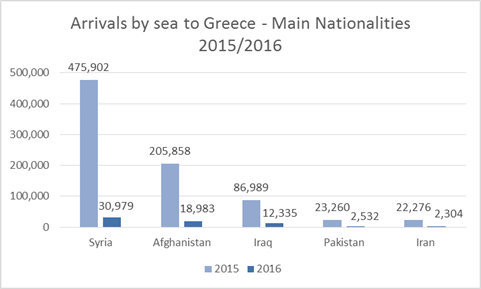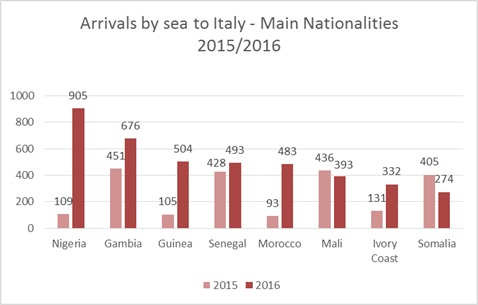-
Who we are
WHO WE AREThe International Organization for Migration (IOM) is part of the United Nations System as the leading inter-governmental organization promoting since 1951 humane and orderly migration for the benefit of all, with 175 member states and a presence in 171 countries.
-
Our Work
Our WorkAs the leading inter-governmental organization promoting since 1951 humane and orderly migration, IOM plays a key role to support the achievement of the 2030 Agenda through different areas of intervention that connect both humanitarian assistance and sustainable development.
What We Do
What We Do
Partnerships
Partnerships
Highlights
Highlights
- Where we work
-
Take Action
Take Action
Work with us
Work with us
Get involved
Get involved
- Data and Research
- 2030 Agenda
Mediterranean Migrant Arrivals in 2016: 141,141; Deaths: 444
Greece - Migrants and refugees are continuing to arrive on the Greek islands from Turkey, according to IOM, despite the presence of NATO vessels newly deployed to thwart smugglers. Total arrivals in Greece and Italy have now reached an estimated 141,141 in 2016.
Arrivals by sea and deaths in the Mediterranean 2015/2016
1 Jan – 7 Mar 2016 |
1 Jan – 31 Mar 2015 |
|||
Country |
Arrivals |
Deaths |
Arrivals |
Deaths |
|
Greece |
131,847 |
347 (Eastern Med route) |
10,535 |
505 (includes all Med routes) |
|
Italy |
9,294 |
97 (Central Med route) |
10,165 |
|
Estimated Total |
141,141 |
444 |
20,700 |
505 |
Country |
Total 2014 |
Total 2015 |
1 Jan – 3 Mar 2016 |
|
Greece |
34,442 |
853,650 |
125,819 |
|
Italy |
170,100 |
153,842 |
9,086 |
Migrants and refugees also continue to die at sea. IOM Athens reported Monday (7/3) a boy, aged 1, died last Wednesday night (2/3) at Mytilene hospital on the island of Lesbos from respiratory problems. The family had reached the island earlier the same day.
On Sunday (7/3) at least 25 migrants were reported drowned in the waters separating Turkey and Greece, bringing the number of fatalities in the Mediterranean to an estimated 443 in 2016, according to IOM’s Missing Migrants Project.
Sadly, Sunday’s 25 deaths do not make it one of the deadliest days in the Mediterranean, or even in the Aegean. The five deadliest days on the Aegean since September 2015 are as follows:
1. October 28, 2015. There were 10 incidents in the Aegean, with a total of 78 deaths. They included two shipwrecks with a total of 43 deaths off Lesbos, and 19 off Kalymnos. Some 13 bodies were washed up on the shores of Lesbos in the following days, indicating there were even more migrants lost at sea.
2. January 21, 2016. There were three incidents in the Aegean with a total of 76 deaths, including two major shipwrecks. The Hellenic Coast Guard reported 44 deaths off the coast of Kalymnos, and a further 24 died sailing to Lesbos.
3. September 20, 2015. There were three incidents with a total of 54 deaths in the Aegean. One shipwreck was off the coast of Lesbos, killing 26, while another 26 were killed after their boat collided with a ferry off the Turkish coast.
4. January 28, 2016. One incident off the coast of Samos killed at least 41 migrants.
5. January 30, 2016. One incident killed 39 migrants on route to Lesbos.


Source: Italian Ministry of Interior (MoI)
· On 6 March 2016, 2,618 arrivals were registered. Numbers are not the actual daily arrivals, but the number of migrants officially recorded by the Greek authorities after their arrival. This procedure may take a few days.
· According to data collected by IOM staff on the Greek islands, of the 67,415 migrants and refugees who reached the Greek islands in January 2016, approximately 44 percent were male, 22 percent female and 34 percent children.
· The Greek Coast Guard reports that since the beginning of 2016, a total of 63,038 Syrians; 33,844 Afghans; 21,514 Iraqis; 3,948 Pakistanis and 3,899 Iranians have arrived on the Greek islands.
IOM Rome on Monday (7/3) reported over 200 migrants were rescued at sea and brought to Lampedusa (87) and Augusta (121). The migrants arriving in Lampedusa were exhausted because of rough seas. Sixty-eight migrants rescued at sea were scheduled to arrive in Lampedusa this morning. All are from Sub-Saharan Africa and include 10 women.
According to testimony gathered by IOM staff, many of those rescued reported they had been forced to board the flimsy rubber dinghy. People who refused were beaten up by the smugglers and the vessel was not completely full when it left for Italy.
Arrivals of migrants to Italy in these first weeks of the year have come mainly from Sub-Saharan Africa, especially Nigeria and The Gambia. Nigerians and Gambians accounted for around one third of the 5,273 migrants who arrived in Italy during January 2016.
Over 900 Nigerians arrived in Italy in January, compared to 109 during January 2015. Other nationalities included Gambians, Moroccans, Guineans (Conakry) and Ivorians, according to Italy’s Ministry of Interior.
“I don’t think we can jump yet to any conclusions,” warned Flavio di Giacomo, IOM’s spokesperson in Rome. “January is only one month. Nigeria is the top sending country for the moment. But we know that Eritreans are not used to traveling during the winter. They will start coming in big numbers this spring. We need the February figures to tell where this year’s trend is going.”
For the latest Mediterranean Update infographic please go to:
http://missingmigrants.iom.int/sites/default/files/Mediterranean_Update_8_March_2016.pdf
For latest arrivals and fatalities in the Mediterranean, please visit: http://migration.iom.int/europe
Learn more about Missing Migrants Project at: http://missingmigrants.iom.int
For further information please contact IOM Greece. Daniel Esdras, Tel: +30 210 9912174, Email: iomathens@iom.int or Kelly Namia, Tel: +302109919040, +302109912174, Email: knamia@iom.int
Or Flavio Di Giacomo at IOM Italy, Tel: +39 347 089 8996, Email: fdigiacomo@iom.int
Or Ivona Zakoska at IOM Skopje, Tel. +389 2 30 88 100, Ext. 133 Email: izakoska@iom.int
Or IOM Geneva, Leonard Doyle, Tel: +41-792857123, Email: ldoyle@iom.intor Joel Millman, Tel: + 41 79 103 87 20, Email: jmillman@iom.int